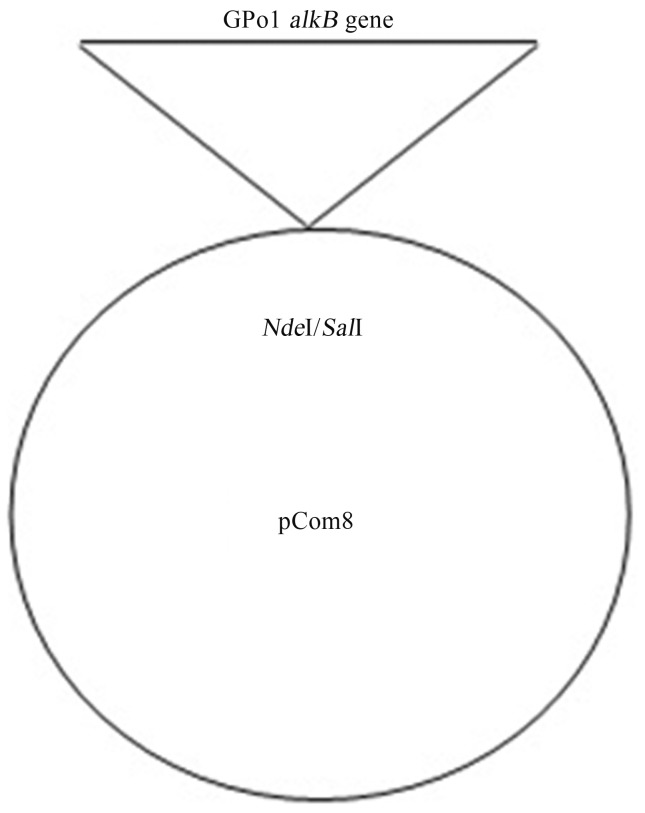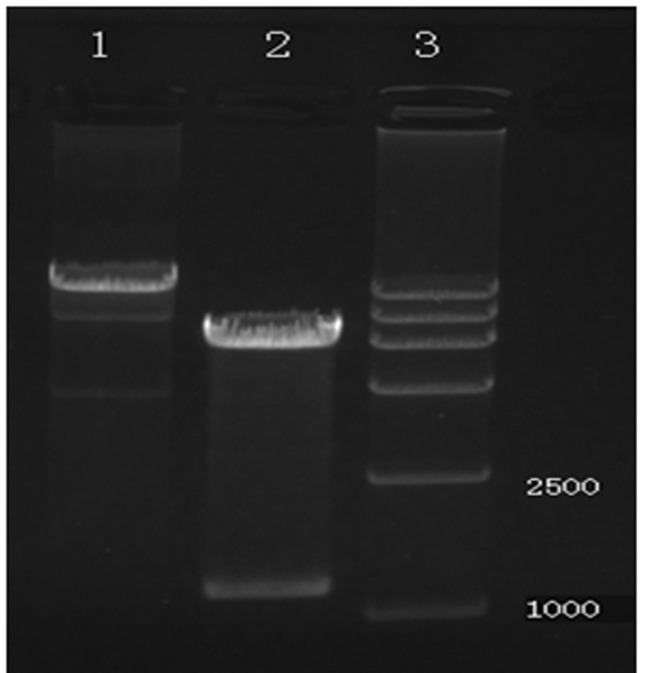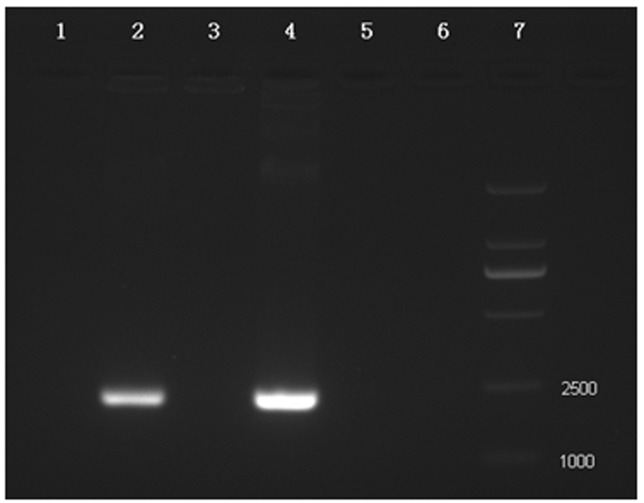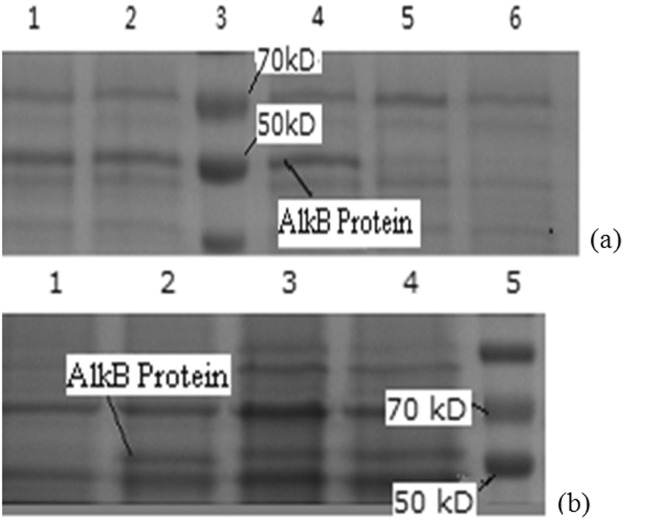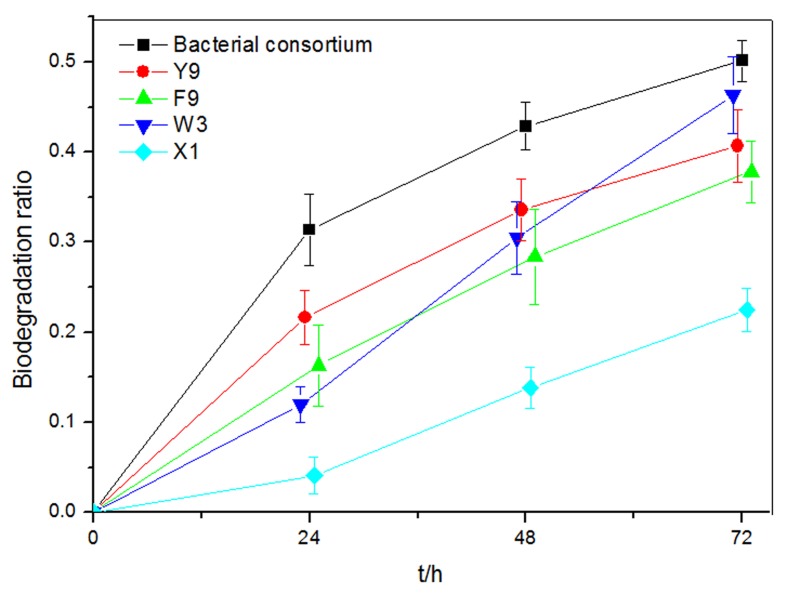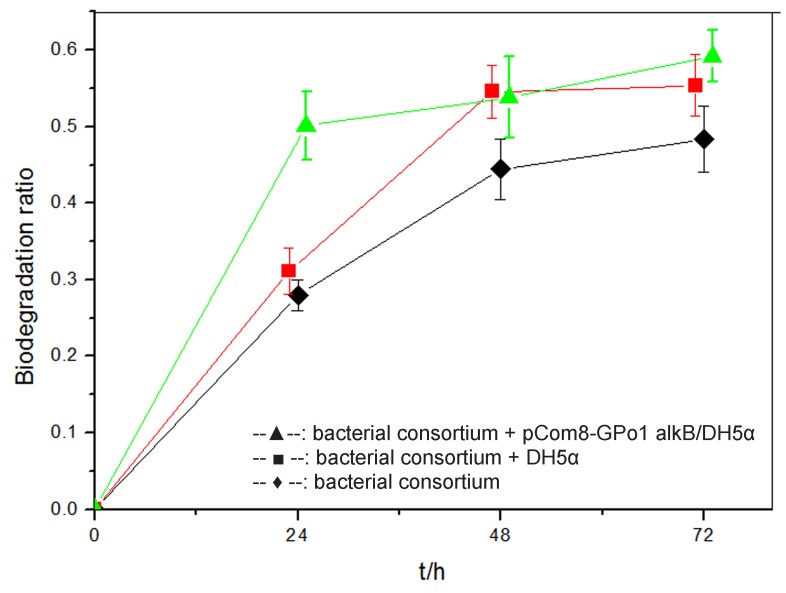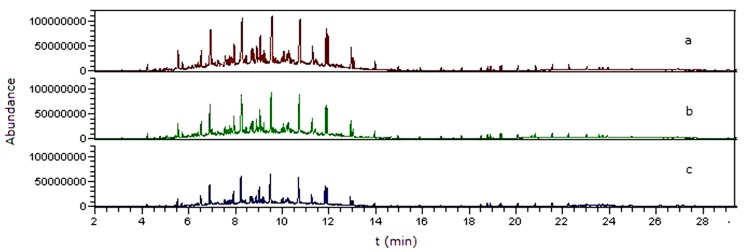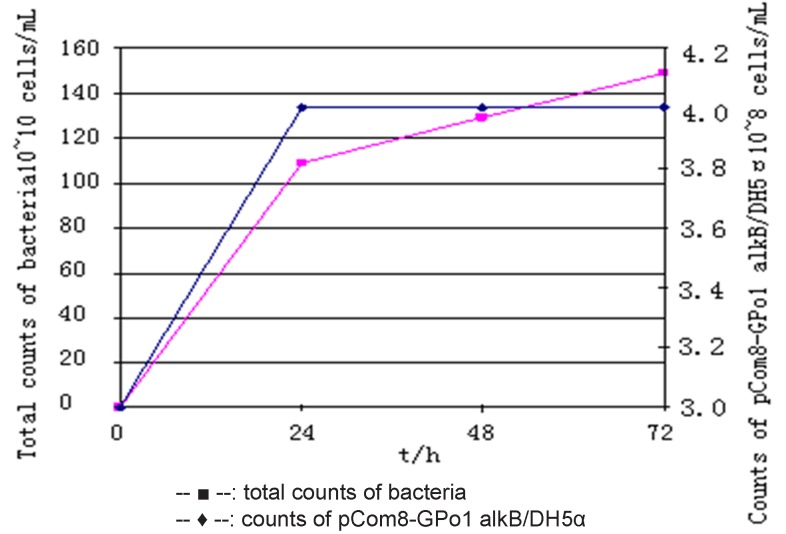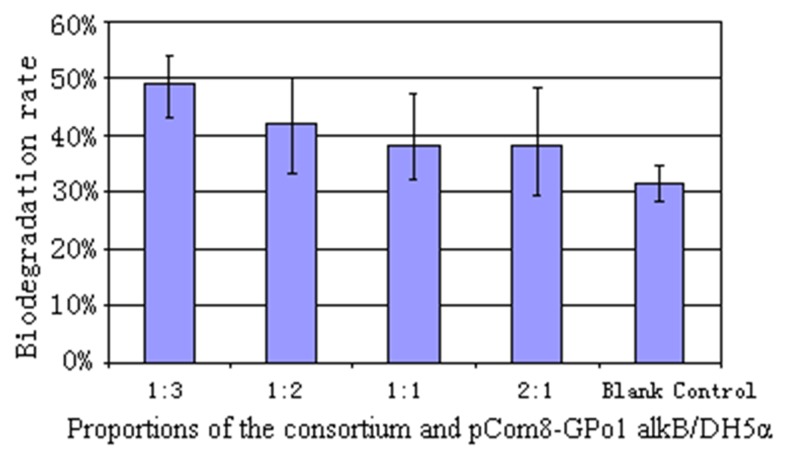Abstract
To facilitate the biodegradation of diesel oil, an oil biodegradation bacterial consortium was constructed. The alkane hydroxylase (alkB) gene of Pseudomonas putida GPo1 was constructed in a pCom8 expression vector, and the pCom8-GPo1 alkB plasmid was transformed into Escherichia coli DH5α. The AlkB protein was expressed by diesel oil induction and detected through SDS-polyacrylamide gel electrophoresis. The culture of the recombinant (pCom8-GPo1 alkB/E. coli DH5α) with the oil biodegradation bacterial consortium increased the degradation ratio of diesel oil at 24 h from 31% to 50%, and the facilitation rates were increased as the proportion of pCom8-GPo1 alkB/E. coli DH5α to the consortium increased. The results suggested that the expression of the GPo1 gene in E. coli DH5α could enhance the function of diesel oil degradation by the bacterial consortium.
Keywords: alkane hydroxylase, expression, Escherichia coli DH5α, biodegradation, diesel oil
Introduction
Marine petroleum pollution has become a great concern to all countries worldwide. Adding the average anthropogenic input and the natural input, the global annual marine oil discharge has been found to be 7 million tonnes (Luise and Thomas, 2005). Aside from the frequency and the amount of oil that regularly pollutes the environment, oil has many adverse properties that threaten the ecosystem and human health (Jeong and Cho, 2007). In recent decades, environmental biotechnology has offered many solutions for marine petroleum pollution and has become a promising technology for sustainable development (Young and Haggblom, 1991). Because microorganisms have diverse catabolic pathways for breaking down many persistent toxic compounds under gentle conditions with no emission and few by-products, biodegradation is believed to have great potential for pollutant treatment.
Due to developments in molecular biology and analytical chemistry, biodegradation pathways for hydrocarbon have been clearly elucidated. Alkanes are chemically quite inert and have to be activated to allow further metabolic steps to take place. The key step of hydrocarbon degradation is the addition of one and sometimes two oxygen atoms to the hydrocarbon molecule, which is then converted to an alkanol (in the case of aliphatic hydrocarbons) or a phenol (in the case of aromatic molecules) (Yong and Zhong, 2010). The alkane hydroxylase (AlkB), which catalyse the first reaction, is the key enzyme in the process of alkane degradation and has received increasing attention. From a biotechnological perspective, alkane hydroxylases are versatile biocatalysts that carry out a wide range of useful oxidation reactions (Grund et al., 1975). Different enzyme systems are known to perform the primary attack for the degradation of hydrocarbon. The alkane hydroxylase system of Pseudomonas putida GPo1 (commonly known as Pseudomonas oleovorans GPo1=TF4-1L=ATCC 29347) (Baptist et al., 1963), which can grow on alkanes ranging from pentane to dodecane and can be used to carry out a wide range of stereo- and regioselective oxidation reactions (Witholt et al., 1990), has been studied in detail with respect to both enzymology (16, 20) and genetics of the n-alkane metabolism (Kok et al., 1989a; Kok et al., 1989b). This alkane hydroxylase is the prototype of a very diverse collection of related non-heme iron integral membrane oxygenases (Shanklin and Cahoon, 1998; Smits et al., 1999). The detection of genes that are closely related to the alkane hydroxylase gene (alkB) of GPo1 in a large fraction of the microbial population in oil-contaminated environments shows that this alkane hydroxylase plays an important role in the degradation of hydrocarbon (Sotsky et al., 1994).
Diesel oil is a complex mixture of different types of hydrocarbons (C6 to C22) and branched alkanes, such as 2,6,10,14-tetramethyl pentadecane (pristine) and 2,4,6,10-tetramethyl hexadecane (phytane). The limiting factor affecting the rate and range of hydrocarbon degradation in diesel oil by microorganisms appears to be the lack of ability of most microbial strains to utilize different components of diesel oil. Different strains can degrade different components, but a single strain can usually attack a limited number of hydrocarbons. Hence, a bacterial consortium is more nutritionally versatile than a single strain and exhibits considerable competence in utilizing a large number of hydrocarbon components from oil. Soli and Bens (Soli and Bens, 1973) successfully used a crude oil biodegradation bacterial consortium composed of different strains that can degrade either aliphatic, aromatic, or polynuclear aromatic hydrocarbons to degrade most components of crude oil.
To facilitate the biodegradation of diesel oil, an oil biodegradation bacterial consortium was constructed in this study. The GPo1 alkane hydroxylase (alkB) gene was synthesized in vitro, and a GPo1 alkB-expression vector, denoted pCom8-GPo1 alkB, was constructed and transformed into E. coli DH5α. The expression of GPo1 AlkB protein in the recombinant (pCom8-GPo1 alkB/E. coli DH5α) induced by diesel oil under different conditions was detected by SDS-polyacrylamide gel electrophoresis (SDS-PAGE). The effects of pCom8-GPo1 alkB/DH5α on the degradation of diesel oil by bacterial consortium were also confirmed.
Materials and Methods
Bacterial strains, plasmid and media
The strains and plasmid used in this study are listed in Table 1. pCom8 is a broad-host-range expression vector for the alkB gene based on pUCP25 and the P. putida GPo1 alkB promoter (Smits et al., 1999).
Table 1. Strains and plasmid used in this study.
| Strain | Relevant genotype, phenotype or characteristic(s) | Source or reference |
|---|---|---|
| Y9 | Acinetobacter sp. | Laboratory collection |
| W3 | Acinetobacter sp. | Laboratory collection |
| F9 | Acinetobacter sp. | Laboratory collection |
| X1 | Gordonia sp. Biosurfactant-producing strain | Laboratory collection |
| E. coli DH5α | recA1 endA1 hsdR17 D lacU169 | Laboratory collection |
| pCom8 | alkB genes expression vector, PalkB; Gmr (gentamicin); oriT; alkS; broad host range | Smits et al., 2001 |
Basal salts medium (BSM; 25 g of NaCl, 0.7 g of KCl, 0.7 g of MgSO47H2O, 1 g of NH4NO3, 2 g of KH2PO4, and 3 g of Na2HPO42H2O) was sterilized for 20 min at 121 °C and supplemented with 2% microelements (sterilized by filtration through a 0.22-μm membrane) at pH 7.5. The medium was supplemented with diesel oil as the sole carbon source. The microelement solution contained 4 g of MgSO47H2O, 1 g of CuSO45H2O, 1 g of MnSO4H2O, 1 g of FeSO47H2O, and 1 g of CaCl2 per litre.
Luria-Bertani (LB) medium, SOB medium and SOC medium were used throughout this study. Gentamicin was used at a concentration of 10 μg mL−1.
Synthesis of the GPo1 alkB gene and construction of the alkB-expressing vector pCom8-GPo1 alkB
The GPo1 alkB gene, including the SalI and NdeI restriction enzyme sites, was synthesized in vitro by Shanghai Major Bio Technology Co. (Shanghai, China).
After digestion with SalI and NdeI, the GPo1 alkB gene was cloned in the pCom8 vector and transformed into competent E. coli DH5α. E. coli strains harbouring the recombinant plasmids were selected by LB medium with 10 μg mL−1 gentamicin. The plasmid DNA was isolated using the High Pure Plasmid Isolation Kit (Takara Bio, China). The recombinant plasmids containing the desired genes from the transformants were identified by PCR, SalI and NdeI enzymolysis digestion and sequencing. The set of specific primers for the target gene was 5′ TTGCTTGATGCGATGTTT 3′ (forward) and 5′ AGTCCGTTCACGATACCC 3′ (reverse). The following PCR programme was used: initial denaturation at 94 °C for 10 min followed by 30 cycles of denaturation at 94 °C for 0.5 min, annealing at 50 °C for 0.5 min, and elongation at 72 °C for 1 min, a final elongation at 72 °C for 10 min and termination at 4 °C. The restriction enzymes, T4 DNA ligase, DNA polymerase, T4 DNA polymerase, and PCR-related reagents were obtained from Shanghai Major Bio Technology Co. (Shanghai, China). The recombinant plasmids from these clones were named pCom8-GPo1 alkB, and the E. coli DH5α strains harbouring recombinant plasmids were named pCom8-GPo1 alkB/DH5α.
Expression of the GPo1 gene in E. coli DH5α
Diesel oil (v/v: 0.5%, 1%, and 2%) was added as an inducer when pCom8-GPo1 alkB/DH5α was in the logarithmic phase (OD600, 0.4) in LB medium with 10 μg mL−1 gentamicin. After 4 h, the fermentation was stopped, and the cells were harvested by centrifugation. At a diesel oil concentration of 1% (v/v), the cells were harvested at different times (2, 4 and 6 h). The cell paste was pelleted (12,000 g, 10 min) and stored at −20 °C until use. The cell paste was resuspended in sterilized ddH20 and boiled for 5 min to disrupt the cells. The protein concentration of the supernatant containing the AlkB protein was determined using the Bradford reagent.
SDS-polyacrylamide gel electrophoresis (SDS-PAGE) was performed using 10% resolving gels (operation voltage: 120 V) and 5% stacking gels (operation voltage: 80 V). Approximately 20 μg of protein was loaded per lane. The gels were stained with Coomassie Brilliant Blue R-250.
Biodegradation assay
Assays to test the degradation of diesel oil were performed in liquid culture using washed cell suspensions. The bacteria were inoculated into HLB medium from agar plates and incubated aerobically at 30 °C on an orbital shaker at 200 rpm for approximately 16 h. When the optical density (OD600) of the bacterial suspension was 1.0, the bacterial suspension was centrifuged for 10 min at 3000 rpm. After the supernatant was discarded and the wet bacteria was washed with sterilized BSM liquid medium, the cell suspensions were inoculated into 250-mL conical flasks containing sterilized liquid culture (per flask: 100 mL of BSM with a specified amount of diesel oil) and incubated in the dark on an orbital shaker at 180 rpm and 30 °C until the time when they were removed for sampling. The remaining oil was extracted three times from the culture fluid with 20 mL of petroleum ether (60–90 °C), and the organic phase was then collected after extraction and analysed using a UV spectrophotometer. Using petroleum ether as the blank reference, the UV absorbance was measured at 255 nm. All biodegradation experiments were performed three times in triplicate, and sterilized cultures without inoculation were used as a negative control.
Construction of the bacteria consortium
Four strains (Y9, W3, F9 and X1) screened from oil-contaminated seawater were chosen for constructing an oil biodegradation bacterial consortium. The construction of the bacterial consortium was optimized via an orthogonal experiment. The trials were performed in BSM inoculated with a 4.0% (v/v) target strain under the principle of equal with 1% (v/v) diesel oil. The cells were incubated at 30 °C with shaking at 180 rpm for three days. The proportion of each inoculated strain was equal in each bacterial consortium. The degradation ratios were detected at 24, 48, and 72 h, as described in the prior section.
Effects of pCom8-GPo1 alkB/DH5α on diesel oil degradation
To investigate the effects of pCom8-GPo1 alkB/DH5α on the degradation of diesel oil by the bacterial consortium, biodegradable assays were performed using three groups: the blank control containing 2 mL of the bacterial consortium (0.5 mL of each of the strains Y9, W3, F9 and X1), the negative control containing 2 mL of the bacterial consortium and 2 mL of strain DH5α, and the experimental group containing 2 mL of the bacterial consortium and 2 mL of strain pCom8-GPo1 alkB/DH5α. The degradation ratio was detected at 24, 48, and 72 h. The bacterial counts were determined using the MPN method. Strain pCom8-GPo1 alkB/DH5α was selected with appropriate antibiotics (gentamicin, 10 μg mL−1).
Five biodegradation assays (Table 2) were prepared to evaluate the effect of different proportions of the bacterial consortium and pCom8-GPo1 alkB/DH5α through biodegradable assays. The degradation ratio was detected at 24 h.
Table 2. Bacterium used for inoculation in the experimental sets.
| Proportion | 1:3 | 1:2 | 1:1 | 2:1 | Blank control |
|---|---|---|---|---|---|
| Bacterial consortium | 2 mL | 2 mL | 2 mL | 2 mL | 2 mL |
| pCom8-GPo1 alkB/DH5α | 6 mL | 4 mL | 2 mL | 1 mL | 0 mL |
Gas chromatography-mass spectrometry analysis
The degradation effect of diesel oil was examined by GC-MS (Thermo Focus DSQ GC-MS, USA). The diesel oil remaining in the liquid culture was extracted three times with 20 mL of dichloromethane. The organic phase was dehydrated with anhydrous sodium sulfate, and 1 μL of the organic phase was analysed by GC-MS. The gas chromatograph was equipped with a split-splitless injector (split ratios of 50:1) and an HP-5 MS column (30 m × 0.25 mm × 0.25 μm; Agilent Technologies). The oven temperature was initially maintained at 60 °C for 2 min, programmed to increase to 300 °C at a rate of 20 °C min−1 and then maintained at this temperature for 5 min. The temperatures of the injector, transfer line and ionization source were all 250 °C. The electron impact ionization was tuned to 70 eV, and helium was used as the carrier gas with an average linear velocity of 1.0 mLmin−1. The mass spectra were recorded within 41–400 amu to collect the total ion current (TIC) chromatograms.
Results
Construction of the alkB-expressing vector pCom8-GPo1 alkB
In this study, the GPo1 alkB gene (approximately 1203 bps in length) was cloned into the multiple cloning sites of the pCom8 vector. The physical map of the recombinant plasmid is shown in Figure 1. The recombinant vector pCom8-GPo1 alkB was transformed into competent E. coli DH5α, and positive transformants were selected by antibiotics (gentamicin, 10 μg mL−1). The recombinant plasmid pCom8- GPo1 alkB was isolated using a High Pure Plasmid Isolation Kit (Takara Bio, China) and prepared for electroporation, and identified by PCR and digestion with SalI and NdeI. The agarose gel electrophoresis results of pCom8-GPo1 alkB, which was digested with SalI and NdeI, are shown in Figure 2. The agarose gel electrophoresis results suggested that the size of the inserted gene fragment was approximately 1200 bps, which is equal to that of the predicated fragment. As shown in Figure 3, pCom8-GPo1 alkB/DH5α and the isolated recombinant plasmid pCom8-GPo1 alkB were used as templates for PCR. The results demonstrated that the transformation was succeeded. The sequencing results also suggested that the recombinant plasmid pCom8-GPo1 alkB was correctly constructed.
Figure 1. Physical map of the recombinant plasmid.
Figure 2. Agarose gel electrophoresis of the results of enzyme digestion: Lane 1, pCom8-GPo1 alkB; 2, pCom8-GPo1 alkBdigestion with SalI and NdeI; and 3, DL15000.
Figure 3. Agarose gel electrophoresis of PCR products: Lane 1, bacterial consortium; 2, pCom8-GPo1 alkB/DH5α; 3, DH5α; 4, pCom8- GPo1 alkB; 5, pCom8; 6, blank control; and 7, DL15000.
Expression of the GPo1 alkane hydroxylase gene
To investigate the expression levels and induction conditions, the protein expression in pCom8-GPo1 alkB/DH5α and E. coliDH5α was identified by SDS-PAGE. The GPo1 AlkB protein was 51 kD. As shown in Figure 4, bands of 51 kD were observed in the lanes of pCom8-GPo1 alkB/DH5α. These bands correspond to the GPo1 AlkB protein. The grey level of the different bands revealed the differences in expression level between induction and noninduction conditions, but there was no significant difference when pCom8-GPo1 alkB/DH5α was induced with different concentrations of diesel oil. The expression levels increased slightly with an increase in the induction time.
Figure 4. Protein gels of the GPo1 alkB gene. a, induction with different concentrations of diesel oil: 1, 2%; 2, 1%; 3, protein marker; 4, 0.5%; 5, noninduction; 6, DH5α noninduction. b: induction for different times: 1, DH5α noninduction; 2, 2 h; 3, 4 h; 4, 6 h; 5, protein marker.
Construction of diesel oil biodegradation bacterial consortium
To facilitate the biodegradation of diesel oil, four strains (Y9, W3, F9 and X1) screened from oil-contaminated sea were chosen to construct an oil biodegradation bacterial consortium. The strains Y9, W3 and F9 were Acinetobacter sp., which can use diesel oil as the sole carbon source and degrade most components of diesel oil, and strain X1 was a biosurfactant-producing strain. The biodegradation ratio of the bacterial consortium, which was composed of four strains (Y9, W3, F9 and X1), was higher than that of the other consortiums (data not shown), and it was adopted for further investigations of the target.
As shown in Figure 5, the biodegradation ratios of the optimal bacterial consortium were obviously higher than those of the strains Y9, W3, F9 and X1 alone from 24 to 72 h. At 24 h, the biodegradation ratio of the consortium reached 31%, but the strains Y9, W3 and F9 required 48 or 72 hours, and strain X1 required much more than 72 h to achieve this ratio. The biodegradation ratio of the consortium was still higher (50%) than those of the strain Y9, W3, F9 and X1 alone (35%, 37%, 42% and 22%, respectively) at 72 h.
Figure 5. Biodegradation ratio of diesel oil by the consortium and the strains Y9, W3, F9 and X1 alone. The error bars indicate the SDs.
Effect of pCom8-GPo1 alkB/DH5α on the degradation of diesel oil by the bacterial consortium
The biodegradation ratios of the blank control (consortium), negative control (consortium + DH5α) and experimental group (consortium + pCom8-GPo1 alkB/DH5α) at 24, 48, and 72 h, are shown in Figure 6. At 24 h, the biodegradation ratio of the experimental group (50%) was obviously higher than those of the negative control (31%) and blank control (27%). These results suggested that pCom8-GPo1 alkB/DH5α promotes the earlier degradation of diesel oil by the consortium and markedly improved the degradation ratio. The biodegradation ratio of the negative control (31%) was slightly higher than that of the blank control (27%) probably because E. coli DH5α can also utilize the by-products of the consortium. After 24 h of incubation, the remaining diesel oil in the experimental cultures was extracted three times with 20 mL of dichloromethane. The organic phase was then dehydrated with anhydrous sodium sulfate, and 1 μL of the organic phase was analysed by GC-MS. The chromatograms of the remaining diesel oil are shown in Figure 7. Diesel oil was chosen as the model oil substrate due to its extensive applications in industrial fuels and the power supply for transportation. The components of diesel oil identified on the chromatogram were mixed hydrocarbons (C11–C21), and all of the components of the diesel oil could be degraded. The abundance of the remaining diesel oil in the experimental group was lower than those of the blank control and negative control.
Figure 6. Effect of pCom8-GPo1 alkB/DH5α on the degradation of diesel oil by the bacterial consortium. The error bars are the SDs.
Figure 7. Chromatogram of the remaining diesel oil in the experimental culture: a, blank control; b, negative control; and c, experimental group.
The total counts of bacteria and the counts of pCom8-GPo1 alkB/DH5α in the experimental group during the diesel oil degradation process are shown in Figure 8. The counts of pCom8-GPo1 alkB/DH5α increased from 3×108 to 4×108 cells mL−1 at 24 h and remained relative constant at 48 and 72 h. The total counts of bacteria increased obviously from 1×1010 to 110×1010 cells mL−1 at 24 h and then increased slowly from 130×1010to 150×1010 cells mL−1 over the next 48 h. These tendencies were consistent with the biodegradation ratio of the experimental group, which increased very rapidly over the first 24 h and slowly over the next 48 h. After 24 h, the bacteria were in the stable phase, during which the counts remained relative constant, and the biodegradation ratio grew slowly. This result was in agreement with those of another study conducted in our laboratory (Luo et al., 2013).
Figure 8. Total counts of bacteria and counts of pCom8-GPo1 alkB/DH5α in the experimental group during diesel oil degradation.
The effects of different proportions of the consortium and pCom8-GPo1 alkB/DH5α on the degradation ratio of diesel oil were also investigated. As shown in Figure 9, the degradation ratios obtained with different proportions were 38.2%, 38.3%, 42.1% and 49.1% at 24 h, all of which higher than that of the blank control (31.4%). The biodegradation ratio decreased with an increase in the proportion of the consortium and pCom8-GPo1 alkB/DH5α, indicating that the facilitation rates increased as the proportion of pCom8-GPo1 alkB/DH5α increased. This was probably because more pCom8-GPo1 alkB/DH5α can express more AlkB protein, which oxidizes n-alkanes to 1-alkanols, and improve the degradation ratio of diesel oil.
Figure 9. Biodegradation ratio of diesel oil by different proportions of the bacterial consortium and pCom8-GPo1 alkB/DH5α at 24 h. The error bars are the SDs.
Discussion
The use of bioremediation as a supplemental cleanup strategy in the Exxon Valdez oil spill in Prince William Sound, Alaska, has proven to be a good example of the problems and successes associated with the practical application of this technology. Biodegradation as a natural process may proceed slowly and is a long-term (weeks to months) process from a response point of view. Biodegradation has been popularized as the ‘ultimate’ solution to oil spills but not as the first-response tool. The slow rate of the biodegradation process is a bottleneck that limits its application for site remediation. Various methodologies of bioremediation have been applied to increase the rate or extent of the biodegradation process, including optimizing various physical, chemical, and biological conditions in the contaminated environment, constructing degrading bacterial consortiums, and genetic engineering bacteria.
Various genetic approaches have been developed and used to optimize the enzymes, metabolic pathways and organisms relevant for biodegradation. New information on the metabolic routes and bottlenecks of degradation is still being accumulated, enlarging the available toolbox. The first and key step in alkane metabolism is the terminal hydroxylation of alkanes to 1-alkanols, a reaction catalysed by a family of integral-membrane diiron enzymes related to Pseudomonas putida GPo1 AlkB by a diverse group of methane, propane, and butane monooxygenases and by some membrane-bound cytochrome P450s (Funhoff et al., 2006). The Pseudomonas putida GPo1 alkane hydroxylase can oxidize n-alkanes to 1-alkanols. pCom8, which contains oriT, alkS (Canosa et al., 2000), and PalkB (Pseudomonas putida (oleovorans) GPo1 alkBpromoter) (Smits et al., 1999), was a useful expression vector for heterologous expression and exhibited a medium to high copy number in E. coli. The expression of the PalkB promoter was modulated by catabolite repression depending on the carbon source being used (Yuste et al., 1998; Staijen et al., 1999). The positive regulator of PalkB, AlkS (Canosa et al., 2000), could be activated by C7–C12 n-alkanes, alkenes, and gratuitous inducers (Grund et al., 1975; Wubbolts, 1994). In this study, the expression of the GPo1 AlkB protein in pCom8-GPo1 alkB/DH5α indicated that diesel oil was used as the carbon source for pCom8-GPo1 alkB/DH5α because it causes the catabolite repression of PalkB. The culture of pCom8-GPo1 alkB/DH5α with the oil biodegradation bacterial consortium, which was constructed successfully to improve the biodegradation of diesel oil, increased the degradation ratio of diesel oil from 31% to 50% at 24 h, and the facilitation rates were increased as the proportion of pCom8-GPo1 alkB/DH5α increased. These results suggested that pCom8-GPo1 alkB/DH5α and the consortium can use each other’s intermediate metabolites, and the expression of GPo1 AlkB, which can oxidize n-alkanes to 1-alkanols, would accelerate the biodegradation of diesel oil. This finding also indicated that the first step in alkane degradation may be the rate-limiting step and that GPo1 alkane hydroxylase plays an important role in the first step of alkane metabolism.
In summary, in this study, an oil biodegradation bacterial consortium was constructed for the biodegradation of diesel oil using three Acinetobacter sp. strains and one biosurfactant-producing strain. The findings demonstrated that the expression of GPo1 AlkB in pCom8-GPo1 alkB/DH5α improved the rate of diesel oil degradation by the consortium. These results not only provide an effective method for improving the biodegradation rate of diesel oil but also suggest a feasible way to construct multi-plasmid genetically engineered microorganisms for rapid degradation hydrocarbon, which is now in progress in our laboratory. With the development of an effective biodegradation technology, the study of the bioremediation of marine oil pollution would undergo further progress.
Acknowledgments
This work was supported by a grant from the Shanghai Natural Science Foundation of China (No. 08ZR1401300).
References
- Baptist JN, Gholson RK, Coon MJ. Hydrocarbon oxidation by a bacterial enzyme system: I Products of octane oxidation. Biochim Biophys Acta. 1963;69:40–47. doi: 10.1016/0006-3002(63)91223-x. [DOI] [PubMed] [Google Scholar]
- Canosa I, Sanchez-Romero JM, Yuste L, et al. A positive feedback mechanism controls expression of AlkS, the transcriptional regulator of the Pseudomonas oleovorans alkane degradation pathway. Mol Microbiol. 2000;35:791–799. doi: 10.1046/j.1365-2958.2000.01751.x. [DOI] [PubMed] [Google Scholar]
- Funhoff EG, Bauer U, Garcia-Rubio I, et al. CYP153A6, a soluble P450 oxygenase catalyzing terminal-alkane hydroxylation. J bacterial. 2006;188:5220–5227. doi: 10.1128/JB.00286-06. [DOI] [PMC free article] [PubMed] [Google Scholar]
- Grund A, Shapiro J, Fennewald M, et al. Regulation of alkane oxidation in Pseudomonas putida . J Bacteriol. 1975;123:546–556. doi: 10.1128/jb.123.2.546-556.1975. [DOI] [PMC free article] [PubMed] [Google Scholar]
- Hou CT, Jackson MA, Bagby MO, et al. Microbial oxidation of cumene by octane-grown cells. Appl Microbiol Biotechnol. 1994;41:178–182. [Google Scholar]
- Jeong WG, Cho SM. Long-term effect of polycyclic aromatic hydrocarbon on physiological metabolisms of the Pacific oyster Crassostrea gigas. Aquacult. 2007;265:343–350. [Google Scholar]
- Kok M, Oldenhuis R, van der Linden MPG, et al. The Pseudomonas oleovorans alkBAC operon encodes two structurally related rubredoxins and an aldehyde dehydrogenase. J Biol Chem. 1989a;264:5442–5451. [PubMed] [Google Scholar]
- Kok M, Oldenhuis R, van der Linden MPG, et al. The Pseudomonas oleovorans alkane hydroxylase gene sequence and expression. J Biol Chem. 1989b;264:5435–5441. [PubMed] [Google Scholar]
- Luise BC, Thomas H. Geo-biological aspects of coastal oil pollution. Palaeogeogr Palaeocl. 2005;219:171–189. [Google Scholar]
- Luo Q, Zhang JG, Shen XR, et al. Isolation and characterization of marine diesel oil-degrading Acinetobacter sp. strain Y2. Ann Microbiol. 2013;63:633–640. [Google Scholar]
- Shanklin J, Cahoon EB. Desaturation and related modifications of fatty acids. Annu Rev Plant Physiol Plant Mol Biol. 1998;49:611–641. doi: 10.1146/annurev.arplant.49.1.611. [DOI] [PubMed] [Google Scholar]
- Smits THM, Röthlisberger M, Witholt B, et al. Molecular screening for alkane hydroxylase genes in Gram-negative and Gram-positive strains. Environ Microbiol. 1999;1:307–318. doi: 10.1046/j.1462-2920.1999.00037.x. [DOI] [PubMed] [Google Scholar]
- Sotsky JB, Greer CW, Atlas RM. Frequency of genes in aromatic and aliphatic hydrocarbon biodegradation pathways within bacterial populations from Alaskan sediments. Can J Microbiol. 1994;40:981–985. doi: 10.1139/m94-157. [DOI] [PubMed] [Google Scholar]
- Soli G, Bens EM. Selective substrate utilization by marine hydrocarbon oxidize bacteria. Biotech Bioeng. 1973;15:285–297. [Google Scholar]
- Staijen IE, Marcionelli R, Witholt B. The PalkBFGHJKL promoter is under carbon catabolite repression control in Pseudomonas oleovorans but not in Escherichia coli alk1 recombinants. J Bacteriol. 1999;181:1610–1616. doi: 10.1128/jb.181.5.1610-1616.1999. [DOI] [PMC free article] [PubMed] [Google Scholar]
- Ueda T, Lode ET, Coon MJ. Enzymatic v-oxidationVII Reduced diphosphopyridine nucleotide-rubredoxin reductase: properties and function as an electron carrier in v-hydroxylation. J Biol Chem. 1972a;247:5010–5016. [PubMed] [Google Scholar]
- Ueda T, Lode ET, Coon MJ. Enzymatic v-oxidation VI Isolation of homogeneous reduced diphosphopyridine nucleotide-rubredoxin reductase. J Biol Chem. 1972b;247:2109–2116. [PubMed] [Google Scholar]
- Witholt B, de Smet MJ, Kingma J, et al. Bioconversions of aliphatic compounds by Pseudomonas oleovorans in multiphase bioreactors: background and economic potential. Trends Biotechnol. 1990;8:46–52. doi: 10.1016/0167-7799(90)90133-i. [DOI] [PubMed] [Google Scholar]
- Wubbolts MG. Xylene and Alkane Mono-oxygenases from Pseudomonas putida. University of Groningen; Groningen, The Netherlands: 1994. PhD Thesis. [Google Scholar]
- Young LY, Haggblom MM. Biodegradation of toxic and environmental pollutants. Curr Opin Biotechnol. 1991;2:429–435. doi: 10.1016/s0958-1669(05)80151-x. [DOI] [PubMed] [Google Scholar]
- Yong YC, Zhong JJ. Recent advances in biodegradation in China: New microorganisms and pathways, biodegradation engineering, and bioenergy from pollutant biodegradation. Process Biochem. 2010;45:1937–1943. [Google Scholar]
- Yuste L, Canosa I, Rojo F. Carbon-source dependent expression of the PalkBpromoter from the Pseudomonas oleovorans alkane degradation pathway. J Bacteriol. 1998;180:5218–5226. doi: 10.1128/jb.180.19.5218-5226.1998. [DOI] [PMC free article] [PubMed] [Google Scholar]



